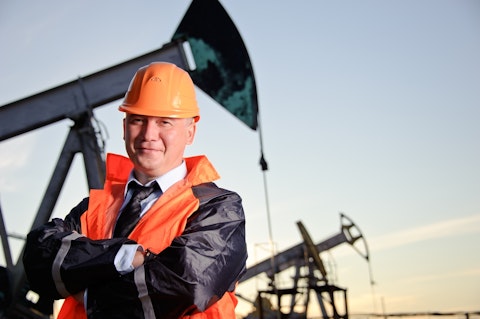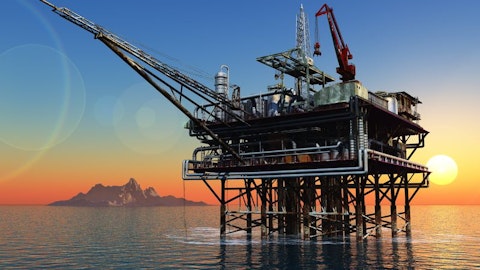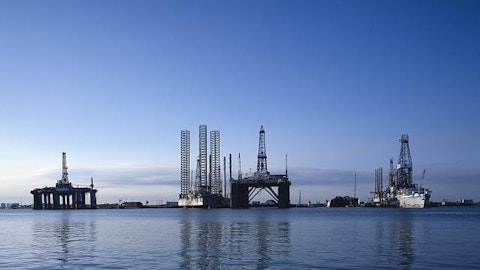Seadrill Limited (NYSE:SDRL) Q2 2023 Earnings Call Transcript August 17, 2023
Lydia Mabry: Welcome to Seadrill’s Second Quarter 2023 Earnings Call. With me today are Simon Johnson, our President and Chief Executive Officer; Grant Creed, Executive Vice President and Chief Financial Officer; and Samir Ali, Executive Vice President and Chief Commercial Officer. Before we begin, I would like to remind you that some of today’s comments are forward-looking statements within the meaning of federal securities laws. They involve risks and uncertainty and actual results may differ materially. No one should assume these forward-looking statements remain valid later in the quarter or year. For a more detailed discussion of the major risk factors affecting our business, please refer to our latest Form 6-K filed with the U.S. Securities and Exchange Commission.
Our comments also include non-GAAP measures. Reconciliations to the nearest corresponding GAAP measures are in our earnings release available on our website. Later in the call following our prepared remarks, we will host a question-and-answer session. Please limit yourself to 1 question and 1 follow-up to permit more participation. Now let me turn the call over to Simon.

ded pixto/Shutterstock.com
Simon Johnson: Hello, everyone, and thank you for joining us on today’s call. For the second quarter of 2023, Seadrill reported adjusted EBITDA of $159 million on $414 million of revenue, which resulted in an industry-leading adjusted EBITDA margin of 38.4%. We benefited from a full quarter’s contribution from contracted rigs acquired via our Aquadrill transaction. A larger fleet size along with continued solid performance from existing operations drove the 56% increase in revenue and 87% increase in adjusted EBITDA from the prior quarter. We’ve had a lot of activity at Seadrill over the past 18 months that have simplified and strengthened our business. This includes monetizing noncore assets, streamlining our operating structure, enhancing scale and capacity, high grading our fleet and establishing a more efficient capital structure.
So before Samir discusses commercial activity and outlook and Grant reviews financial results, I want to spend the initial part of today’s call reintroducing you to Seadrill. At Seadrill, we strive to operate at scale achieved through a combination of market selection and fleet refinement supported by capital discipline. Why do we care about scale? Because simply put, scale supports success. It affords contracting flexibility, lowers our cost to operate and helps attract and retain critical talent. We’re able to offer customers a more complete rig portfolio with options on technologies, pricing and availability, which makes us more commercially competitive. We can share shore-based support, people and spare parts across a larger base of operations as well as performance gains and best practices improving overall efficiency.
Lastly, we can invest in developing local talent, providing them employment stability and career pathways in the countries where we operate. Size differs from scale. If we exclude the 3 jackups we have listed for sale, Seadrill operates an 18-rig fleet. While we may be smaller than certain other global drillers, we are still the fourth largest listed contractor and by focusing our floating rigs in key operating markets, we achieve significant local scale. Globally, our customers increasingly desirous of better resource, resilient contractors who can support their success through time; drilling contractors with scale, contractors like Seadrill. We concentrate our rigs around good rocks and attractive geographies resilient to changes in oil price and market fortunes achieving scale in markets that matter.
Today, Seadrill is the leading international driller in Brazil, the #1 operator of rigs in Angola and an established presence in the Gulf of Mexico. We have strong exposure and leverage to these 3 regions. They represent nearly 70% of our $2.6 billion quarter-ending backlog and are home to 12 of our 14 active floaters or nearly 80%. Early in the cycle you may see us take advantage of relocating rigs where they have the best opportunities. Though our focus remains Golden Triangle Plus, we remain open to contracting in other attractive hydrocarbon bases where we can capitalize on rising rates, build a more formidable backlog or to establish a pathway to scale. Currently, we market a modern floater fleet having reduced exposure to noncore asset categories through opportunistic divestitures to become more pure play.
Continued fleet refinement creates economies of scale. It’s more efficient to market, operate and support a fleet of like assets with similar rig designs and equipment packages. In July, we completed the successful sale of 3 tender assisted rigs acquired via the Aquadrill transaction generating approximately $85 million in proceeds. These rigs neither fit with our fleet nor our strategy serving niche shallow water region-specific applications. We also announced plans to sell 3 jackup rigs, which would mark a near complete exit from the jackup business following the sale of 7 jackups in Saudi Arabia last October. The transaction would simplify our fleet and our financials since it involves divesting our associated joint venture interest. These are the same rigs our commercial teams worked tirelessly to extend last quarter.
By selling jackups with contracts as we’ve done in previous transactions, we create value for potential buyers and our shareholders. We are economic dispassionate asset owners. We continuously evaluate the strategic fit of rigs within our fleet. We don’t fall in love with the steel. Operating at scale requires more than concentrating the right rigs in the right regions, it requires discipline. We maintain a well-managed balance sheet and conservative capital structure. Our debt refinancing lowered our cost of capital reducing annual interest expense by over 600 basis points and nearly $50 million compared to 2022. Additionally, it extended maturities by several years and removed restrictive covenants. At Seadrill, we focus on being the best driller not the biggest.
We create the most value for our customers by delivering safe efficient operations and in turn we create the most value for our shareholders by building a business that generates meaningful free cash flow. We announced today that after careful consideration, our Board of Directors authorized a $250 million share repurchase program allowing us to return excess capital to shareholders after exhausting other uses. Their decision reflects confidence in our strategy to operate at scale supported by our demonstrated commitment to market selection, fleet refinement and capital discipline and the positive market outlook. As always, we benefit from the guidance and support of our highly experienced independent directors, including notable industry leaders who have led organizations through similar periods of evolution.
I’m excited about what we’re doing here at Seadrill around the globe, across functions and employees show a bias towards action. They’re committed, they’re creative and they get stuff done. So thank you team for your continued contributions to making Seadrill better every day. With that, I’d like to pass it to Samir to review our recent contracting activity, approach and outlook.
Samir Ali: Thank you, Simon. I’ll begin with our fixtures in the second quarter. In Qatar, an operator exercised options for the West Tucana jackup in direct continuation committing the rig until the third quarter of 2025. In Indonesia, an operator exercised an option for the West Capella drillship extending its contract by approximately 2 months through August of 2024. Lastly, in Angola, a client exercised an option for 2 Sonadrill drillships. The multiwell extensions will secure the Sonangol Quenguela through January 2025 and the West Gemini through May 2025. These extensions represent a material uplift to the rig’s current day rate. However, I would highlight that these were fixed priced options and they do not reflect current market rates which are higher.
Excluding cold-stacked assets, 97% of our active fleet is contracted through 2023. Right now we have 5 to 7 floaters with upcoming availability and we’re currently looking to recontract them over the next 12 to 18 months. 2 floaters, West Polaris and the Sevan Louisiana, finish their existing contracts by year-end. A third, the West Auriga finishes in the first quarter of 2024. Late next year we may have an additional 2 to 4 floaters available for work subject to customer decisions to extend previously negotiated options. As rigs roll off contract, we may take the opportunity to relocate them to more attractive markets. Don’t be surprised if we willingly accept idle time to reposition rigs for the right opportunities. Intercountry mobilization get more difficult and more costly the longer you wait.
We balance our near-term exposure to rising day rates in our recovering market with solid long-term contracts that generate consistent cash flow. 5 of our rigs are contracted through much of 2025, including 4 in Brazil. The West Saturn, which showcases rig automation and emissions technologies, is on contract through 2026. And in Norway, the West Elara, a harsh environment jackup, is contracted into the first quarter of 2028. We take a portfolio approach to our recontracting. By staggering end dates, we intend to create a smooth contract expiration profile that balances near-term market exposure with revenue certainty. In the early phases of a market recovery, we prefer not to put contracts with too much duration. When you consider our key operating geographies, duration tends to vary; Brazil takes in years, West Africa in months and the Gulf of Mexico in days.
Yes, this is somewhat oversimplified, but illustrative all the same. Frankly, right now we are not seeing demand for many long-term contracts outside of markets like Brazil where they are still in demand. While some IOCs might choose to secure rates in a tightening market, for now we see long-dated contracts in being the exception rather than the rule. Looking ahead, we expect continued development of the offshore drilling market, particularly where we have focused within deepwater. Gross rig utilization is trending above 90% and in our key operating regions within the Golden Triangle, utilization is closing in on 100% as demand outpaces supply. Assuming limited rig additions to the existing sideline capacity like stacked rigs and stranded assets or what we refer to as not so newbuilds, the market is poised for a sustained upcycle.
And now I’ll turn the call over to Grant.
Grant Creed: Thanks, Samir. I’ll discuss our second quarter results before outlining our recent refinancing and capital allocation approach. In the second quarter, Seadrill generated $414 million in total operating revenues, an increase of $148 million or 56% from the prior quarter. This includes $329 million of contract drilling revenues, which increased sequentially by $143 million or 77% primarily due to an increase in operating days now that the Aquadrill rigs are included in Seadrill’s results. In today’s press release, we included the basic calculation many of you are likely already using to derive contract drilling revenues based on the number of contracted rigs in our fleet, the day rate they earn and the economic utilization they achieve.
The arithmetic will get you close to reported contract drilling revenues, but will always differ somewhat from the actual numbers since day rate as defined does not always capture the total contract value. Here’s why. First, day rates never include performance bonuses awarded for achieving operational targets. Second, we often provide customers with additional services like managed pressure drilling or equipment monitoring. Whether we charge those as part of our day rate or as a separate line item varies by client, region and service providers. Third, rates sometimes include revenues related to moving a rig to and from its intended drilling location or mob and demob. Sometimes they don’t. Often it depends on the extent of the relocation.
This quarter we reported economic utilization of 93%, slightly less than target due to weather-related impacts and onetime operational events. A Seadrill owned rig that is managed by a third party contributes a significant portion of the unplanned downtime. We can’t predict unplanned downtime, but we can prepare for it. At Seadrill, we minimize its impact by crewing our rigs with experienced educated teams who can recognize and react to potential problems, providing access to critical spare parts on deck and onshore and supporting the crew with expert technical services, which ensures their continued delivery of safe and efficient operations. Beyond contract drilling revenues, we generated additional revenues from management contracts largely related to 3 floating rigs we operate in Angola as part of the Sonadrill joint venture and that’s the West Gemini, Sonangol Libongos and Sonangol Quenguela and that totaled $66 million for the quarter.
We earned an additional $19 million in reimbursable and other revenues. Operating expenses for the quarter increased 41% sequentially to $308 million owing largely to our change in fleet size. Rig operating costs, which consists primarily of labor, remains under pressure as inflation continues to creep higher and the market for skilled rig crews remains tight in certain geographies. When you consider our floaters have a manning of roughly 160 people working across 2 rotating shifts or tools, you can appreciate the potential magnitude of this impact. Our second quarter numbers also include onetime merger and integration-related expenses of $16 million. This translates into adjusted EBITDA of $159 million resulting in 38.4% adjusted EBITDA margin, a 640 basis point improvement from the prior quarter.
Now on to the balance sheet. Cash flow from operations of $20 million for the quarter were negatively impacted by working capital movements including accounts receivable build related to the timing of cash receipts, increased operating days and higher rates in respect to certain rigs, reduction of accounts payable and accruals incurred late last year and early this year in respect to the mobilization and operations preparation of the 4 rigs in Brazil and finally, the timing of funding payments made to the Aquadrill rig managers. Long-term maintenance costs of $23 million, which are included within operating activities within the cash flow statement and $14 million of rig equipment additions resulted in total CapEx of $37 million for the quarter.
Year-to-date we have spent $58 million in CapEx having deferred much of our spending to the second half of the year. Unlike last year where we had big capital projects related to rig reactivations and upgrades, this year’s spending thus far consists of several investments to enhance the marketability and operating life of rigs across our fleet. Later in the year, we expect CapEx spending to increase as we begin purchasing long-lead items related to special periodic surveys or SPSs scheduled for next year. Our guidance for the full year remains unchanged from when we provided it last quarter. And to recap, we anticipate total operating revenues to be between $1.44 billion and $1.49 billion, adjusted EBITDA to be $435 million to $485 million and CapEx and long-term maintenance to be between $210 million and $250 million.
Now moving on to our recent refinancing. After quarter-end, we completed a successful debt offering at competitive rates issuing $575 million in senior secured second lien notes at 8 3/8%, substantially lowering our cost of capital. Additionally, we established a $225 million revolving credit facility. We used most of the proceeds on the refinancing to pay down the outstanding amounts of our existing debt facilities and related transaction and exit fees. Approximately $230 million of net proceeds remain on our balance sheet. At quarter-end, Seadrill had total debt of $355 million and $539 million in cash and cash equivalents, including $127 million in restricted cash. The value accretive divestitures, Simon mentioned earlier, would further fortify our balance sheet as well improving cash flow from operations as the cycle continues.
I now want to spend some time discussing how we approach capital allocation. First, we must maintain an appropriate level of cash to run our business effectively. Cash requirements may fluctuate with the changing size of our rig fleet, evolving maturity of our business model and emerging upcycle. As operators of a capital-intensive business in a cyclical industry, we value conservative balance sheet management and intend to maintain prudent net leverage ratios throughout the cycle in line with well-capitalized peers. Next, we must invest in maintaining and servicing our existing rig fleet ensuring we continue to deliver safe and efficient operations to our customers and preserve our license to operate. Recognizing the visibility we have into maintenance schedules, we may occasionally reserve cash in anticipation of higher volumes of work, particularly related to SPS as required by regulatory agencies like ABS and DNV and completed every 5 years to ensure whole classification.
We start planning for SPSs years in advance identifying the scope of work to be undertaken before starting more detailed planning. We plan to undergo a high number of SPSs within the next 2 years since we have a large number of rig anniversaries that land in the same year. Expect us to set aside cash to finance what could be large projects. Then we evaluate the potential for investments in our core asset categories we believe will generate strong returns on capital. This could mean investing in our existing fleet to upgrade capabilities and adopt new technologies, both of which enhance the marketability or lives of our rigs. It could also mean making disciplined acquisitions. Only once we have financed these 3 primary uses of cash; strengthening the balance sheet, maintaining our fleet and making accretive investments; will we evaluate returning excess capital to shareholders with the intention of ultimately returning the majority of our free cash flow to shareholders.
The Board’s repurchase authorization gives us the necessary tool to fulfill this final objective. The $250 million repurchase program does not have a fixed duration or expiration nor does it obligate us to purchase any shares. It simply allows us the opportunity to evaluate and act upon potential opportunities to return cash to shareholders when competing uses for cash are unavailable elsewhere in our business. With that, I’ll return to Simon for closing remarks.
Simon Johnson: Over the past 18 months, Seadrill simplified and strengthened our business. We have achieved significant scale in target markets concentrating our modern floater focused fleet largely within the Golden Triangle to achieve scale benefits that improve execution and maximize shareholder value. Market fundamentals reinforce our view that this emerging upcycle will be long and durable. Early in the cycle expect us to take advantage of available opportunities to strengthen the organization and deepen our competitive advantage, whether that relates to market selection, fleet refinement or capital discipline. As I stated earlier, we strive to be the best not the biggest, creating value across stakeholder groups including our customers, employees and their shareholders.
Our share repurchase program provides a new tool we may use to deliver that value. The Board’s $250 million authorization reflects confidence in our strategy to operate at scale and positive market outlook. I would now like to open the call up for questions.
See also 20 Best Web Designing Tools for Developers and Vodka Consumption by Country: Top 20 Countries.
Q&A Session
Follow Seadrill Ltd (NYSE:SDRL)
Follow Seadrill Ltd (NYSE:SDRL)
Operator: [Operator Instructions] Our first question comes from Greg Lewis from BTIG.
Greg Lewis: I did have kind of a broader question before I guess maybe we talk a little bit about individual rigs. But really, Simon, how do you balance the upcoming rig availability on a couple of rigs versus the potential to, I believe in conversation you just kind of highlighted the willingness or really the desire assuming that the terms and pricing are right is to reactivate a rig like the Aquarius for example. So really just trying to gauge how we’re thinking about maybe bidding some of our stacked rigs versus some of our rigs that have availability here over the next 12 months? Just kind of curious on your thoughts around that?
Simon Johnson: Thanks for the question, Greg. Perhaps I can kick off the answer and then Samir can jump on the back end of it. But let me first talk just a little bit about the cold stack rigs and how we think about them. We have 3 at the moment; we have 2 semi-submersibles, 1 of which is a harsh environment rig and also a jackup that’s been long-term stacked in the Far East. And look simply put, we’re not marketing those rigs very hard. We respond to inbound customer queries about them, but we believe that our customers should help bear the cost burden of reactivation and really unless they give a positive response to that, the conversation typically doesn’t go much further. We just feel our customers have a much lower cost of capital on a relative basis than we enjoy.
And if we are to bring additional supply into the market, then they need to bear the burden of applying the capital. Now these units, it’s not demolition through neglect. These units have value in the current condition, but it may not be for us. So we’ll continue to monitor the market, but most of our focus is on ensuring that we have ongoing work for those rigs that are rolling off contracts that are already won today. We believe that we’re very early in the cycle and we’re prepared to take some risk in terms of contract opportunities and we’re focused on getting the right rigs in the right markets. But let me pass to Samir and he can talk specifically about some of the opportunities for those that are rolling in the near term.
Samir Ali: So Greg, it’s Samir. I’d say we are looking for some opportunities for the active fleet that’s rolling off. We’ve got 2 rigs that roll off at the end of this year. I’d say we’re in dialog on both of them. The Gulf of Mexico is still a bit of — as I said earlier, the contracting cycle is a little shorter here and demand pops up kind of closer to when you actually need to drill. So we are in active dialog. We may have some white space on some of our rigs, but we’re optimistic that we’ll be able to recontract the rigs that are rolling off here in the near term.
Greg Lewis: Okay. And then just as I think about the opportunity in the Golden Triangle, let’s just talk maybe about outside the Golden Triangle as we’re focusing in on the Polaris. As we think about that rig and realizing that I believe ONGC may bring another tender to the market, is it plausible to think that rig stays in the region, i.e., the broader call it Asia/India market or actually should we be thinking about that rig potentially mobilizing to the Golden Triangle? And in the event if that rig were to move, any kind of guidance around how we should be thinking about timing and costs of mobilizing that rig to the Atlantic Basin?
Samir Ali: Sure. So I’d say the Polaris, she will roll off here at the end of the year. We are looking to relocate her potentially into other parts of Southeast Asia. Bringing her across to the Gulf, it’s a possibility. But I’d say given her capabilities, we think that’s the right market for her and we are pursuing opportunities within that region. So could it be India? Possibly. Could it be parts of Southeast Asia? Possibly. I think for us, the key thing for us is to bring the rig back under our management. We do pay somebody else to manage it and for us, we’re looking forward to bringing that rig back and putting Seadrill coveralls on that rig and being able to put it to work most likely in that part of the world.
Operator: Our next question comes from Ben Nolan from Stifel.
Ben Nolan: Simon, maybe this one I’ll start with you. I know in the past we’ve had conversations that your expectation the deepwater market was likely to consolidate even further before the end of the year. I’m curious if maybe you could update me on how you’re thinking about that. Is it happening the way that you thought that it would or not and how do you see it going forward?




